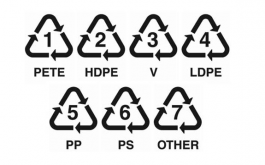 Let’s face the hard reality: Some day you may have to get rid of some water bottles. Maybe you’re moving and need to lighten your load. Perhaps they’ve come to the end of their life span. Or—gasp—you just don’t like a certain water bottle and want to ditch it.
Let’s face the hard reality: Some day you may have to get rid of some water bottles. Maybe you’re moving and need to lighten your load. Perhaps they’ve come to the end of their life span. Or—gasp—you just don’t like a certain water bottle and want to ditch it.
Wait! Don’t throw away your unwanted custom printed bottles. Find out how or if they can be recycled. Yes, you can likely recycle those poor bottles, furthering their sole purpose of decreasing plastics waste (you know, the reason you first switched to reusable bottles in the first place).
So how do you figure this out? Easy…just use the SPI’s resin ID coding system. Huh? What the…? Let us explain:
In the late 1990s, the Society of the Plastics Industry (SPI) introduced a system to help identify the plastics content of bottles and containers commonly found in the typical waste stream. Denoted by the now-familiar triangle and arrow symbol, the number in the center is your key to recycling bliss! Here’s what they mean:
#1 PETE (polyethylene terephthalate). This is the most common single-use bottle material. You will also likely find it in peanut butter, salad dressing, and vegetable oil containers. This resin can be recycled into polar fleece, fiber, tote bags, furniture, and carpeting. This can also be recycled into sports bottles, most often in transparent colors. It’s BPA free.
#2 HDPE (high density polyethylene). It’s what milk jugs, butter and yogurt tubs, and shampoo bottles are usually made of. It is often recycled into laundry detergent bottles, floor tiles, drainage pipe, benches and lumber products. It is also used to manufacture many styles of opaque colored custom printed bottles. It is also BPA free.
#3 V (vinyl/PVC). This one contains phthalates. It should not be used for food packaging and should not be burned or incinerated. This can be recycled for industrial use only and is often recycled into waste and irrigation pipes. Phthalates may not be used in any product if the product is primarily intended for children 12 and under, or if it’s being marketed with designs that children may be attracted to.
#4 LDPE (low-density polyethylene). You’ll find this in squeeze bottles, soft poly bags, furniture, carpet, and many household items (including toys!). It is typically recycled into bike-type bottles and other soft bottles. This plastic is BPA free.
#5 PP (polypropylene). This is found in syrup bottles, ketchup bottles, caps, straws, and many other consumer products. It is recycled into battery cables, brooms and brushes, landscape borders, racks, rakes, and can be used (in part) for reusable bags. It’s BPA free.
#6 PS (polystyrene). Found in disposable plates and cups, meat trays, egg cartons, aspirin bottles, compact disc cases, this one can be recycled into insulation materials, egg cartons, rulers, toys, and industrial products. It, too, is BPA free.
#7 Other (miscellaneous Pplastics not otherwise classified). Tritan™ copolyester, for example, falls into this category. As new safe plastics are developed, they will likely be classified in this recycle code…for now, at least!
So when the time comes to part with your custom printed bottles, now you know how it can be recycled and what it can eventually be made into! Please check with your recycling service to make sure they take the code, as not every company can properly recycle every type of resin.
